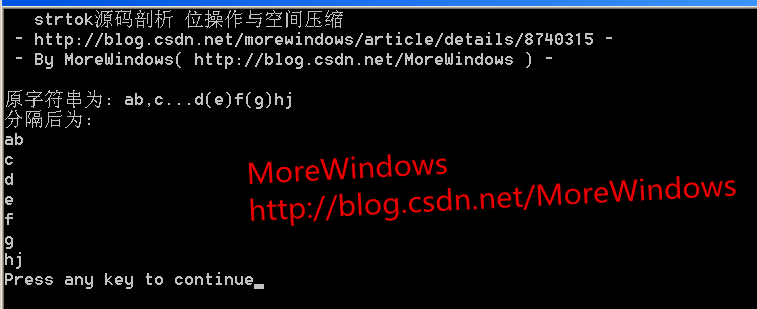地址:http://blog.youkuaiyun.com/morewindows/article/details/8740315转载请标明出处,谢谢。
欢迎关注微博:http://weibo.com/MoreWindows
strtok源码剖析
strtok函数可以用于分隔字符串,最近看了下这个函数的源代码,其中有
unsigned char map[32];/* Clear control map */for (count = 0; count < 32; count++)map[count] = 0;/* Set bits in delimiter table */do { map[*ctrl >> 3] |= (1 << (*ctrl & 7));} while (*ctrl++);这段代码非常有意思,第一眼可能不明白,为什么用个unsigned char map[32];数组来保存分隔字符。下面的map[*ctrl >> 3] |= (1 << (*ctrl & 7));更加有点古怪。在网上查了下,并没有文章来解释,因此写篇博客来解释说明下。
这个长为32的数组与后面的左移,右移操作看起来迷惑,其实如果看过《位操作基础篇之位操作全面总结》(http://blog.youkuaiyun.com/morewindows/article/details/7354571)的“位操作与空间压缩”便不难想到,这里其实是个位操作的空间压缩技巧。因此char类型的数据只会从0到255,因此建立一个哈希表来记录哪些字符要分割,需要则标记为1,否则标记为0,然后在分隔字符串时,就能直接判断字符串的该位置是否要分割。详细请见MyStrtok的实现。
//strtok源码剖析 位操作与空间压缩//http://blog.youkuaiyun.com/morewindows/article/details/8740315//By MoreWindows( http://blog.youkuaiyun.com/MoreWindows )#include <stdio.h>// strtok源码剖析char* __cdecl MyStrtok(char * string, const char * control){ unsigned char *str; const unsigned char *ctrl = (const unsigned char *)control; static unsigned char* _TOKEN = NULL; //注意这里使用了static类型,实际的strtok函数出于线程安全会使用TLS //由于char类型占一个字节取值范围为0~255 //所以可以打个bool flag[255]这样的哈希表 //来记录哪些字符为delimiter characters //然后根据《位操作基础篇之位操作全面总结》中的位操作与空间压缩 //http://blog.youkuaiyun.com/morewindows/article/details/7354571#t6 //可以将数组大小取255/8即32 unsigned char map[32]; int count; // Clear control map for (count = 0; count < 32; count++) map[count] = 0; // Set bits in delimiter table do { //map[*ctrl >> 3] |= (1 << (*ctrl & 7));//strtok原来的代码 map[*ctrl / 8] |= (1 << (*ctrl % 8)); } while (*ctrl++); // Initialize str // If string is NULL, set str to the saved pointer //(i.e., continue breaking tokens out of the string from the last strtok call) if (string != NULL) str = (unsigned char *)string; else str = (unsigned char *)_TOKEN; // Find beginning of token (skip over leading delimiters). Note that // there is no token iff this loop sets str to point to the terminal // null (*str == '\0') //while ( (map[*str >> 3] & (1 << (*str & 7))) && *str )//strtok原来的代码 while ( (map[*str / 8] & (1 << (*str % 8))) && *str ) str++; string = (char *)str; // Find the end of the token. If it is not the end of the string, // put a null there. for ( ; *str ; str++ ) { //if ( map[*str >> 3] & (1 << (*str & 7)) ) //strtok原来的代码 if ( map[*str / 8] & (1 << (*str % 8)) ) { *str++ = '\0'; break; } } // Update nextoken (or the corresponding field in the per-thread data structure _TOKEN = str; // Determine if a token has been found. if ( string == (char *)str ) return NULL; else return string;}int main(){ printf(" strtok源码剖析 位操作与空间压缩\n"); printf(" - http://blog.youkuaiyun.com/morewindows/article/details/8740315 -\n"); printf(" - By MoreWindows( http://blog.youkuaiyun.com/MoreWindows ) - \n\n"); //char szText[] = "MoreWindows (By http://blog.youkuaiyun.com/MoreWindows)"; //char szFind[] = " "; char szText[] = "ab,c...d(e)f(g)hj"; char szFind[] = ",.()"; printf("原字符串为: %s\n", szText); printf("分隔后为: \n"); char *pToken = MyStrtok(szText, szFind); while (pToken != NULL) { printf("%s\n", pToken); pToken = MyStrtok(NULL, szFind); } return 0;}运行结果如图所示(图片不能打开,请访问http://blog.youkuaiyun.com/morewindows/article/details/8740315)

地址:http://blog.youkuaiyun.com/morewindows/article/details/8740315转载请标明出处,谢谢。
欢迎关注微博:http://weibo.com/MoreWindows
再分享一下我老师大神的人工智能教程吧。零基础!通俗易懂!风趣幽默!还带黄段子!希望你也加入到我们人工智能的队伍中来!https://blog.youkuaiyun.com/jiangjunshow




 本文深入剖析strtok函数源码,解读其如何利用位操作进行空间压缩,实现字符串分割功能。通过创建位操作的哈希表,标记分隔符,优化字符串处理效率。
本文深入剖析strtok函数源码,解读其如何利用位操作进行空间压缩,实现字符串分割功能。通过创建位操作的哈希表,标记分隔符,优化字符串处理效率。

















 被折叠的 条评论
为什么被折叠?
被折叠的 条评论
为什么被折叠?








